
Table of contents:
- Russian blue cat: history of the breed, characteristics, care and breeding
- The history of the origin and formation of the breed
- External features of Russian blue
- The character and behavior of the Russian blue cat
- What diseases do Russian blue cats most often suffer from?
- How to care for Russian blue
- Breeding issues of Russian blue
- How to choose a kitten Russian blue
- Reviews of the owners about the breed
- Author Bailey Albertson [email protected].
- Public 2024-01-17 22:26.
- Last modified 2025-06-01 07:32.
Russian blue cat: history of the breed, characteristics, care and breeding

Russian blue cats are one of the most popular breeds in the world. The trend for everything Russian, the mystery of origin, unique physical qualities and character contributed to the natural distribution and popularization of representatives of this breed around the world. Interest in these animals is also growing in Russia, where, contrary to the name, they were re-introduced only in the second half of the 80s of the last century.
Content
- 1 History of the origin and formation of the breed
-
2 External features of Russian blue
2.1 Typical types of the Russian blue cat: American, European, English (gallery)
- 3 The character and behavior of the Russian blue cat
- 4 What diseases do Russian blue cats most often suffer from?
-
5 How to care for Russian blue
- 5.1 Power
- 5.2 Hygiene
- 5.3 Toilet
-
6 Breeding issues of Russian blue
- 6.1 Knitting
- 6.2 Pregnancy
- 6.3 Castration and sterilization
- 7 How to choose a kitten Russian blue
- 8 Owner reviews about the breed
The history of the origin and formation of the breed
Gray cats with a blue tint of fur appear in many myths and legends. Love for them is attributed to family members of the old European aristocracy, whose representative, Catherine II, generously presented her western relatives with amazing cats from Arkhangelsk. The first official description of the breed was published in England in 1903, where cats with green eyes, a characteristic fur color and a dense undercoat were called Arkhangelsk blue.
It was from Arkhangelsk that Miss Constance Carew-Cox brought out several blue cats in 1893 - their number and names differ depending on the sources, but it was these animals that gave birth to the breeding of the Russian blue cat. The breed received its modern name in 1935, when it was officially entered into the British Studbook.
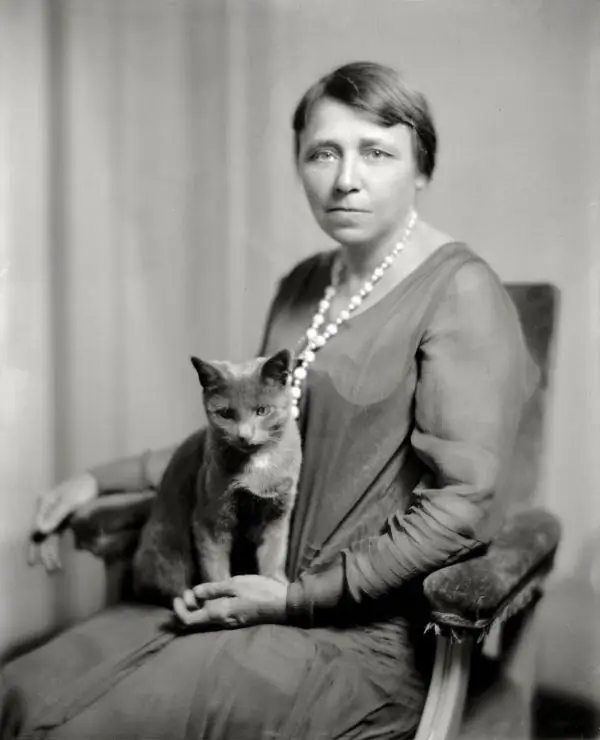
Hattie Wyatt Caraway and her Russian blue cat, 1925
Where these cats came from remains unknown. Aboriginal cats of the north of Russia have the same double "blue" hair, but they are more stocky, have short limbs, and their eyes are mostly round and yellow. In Europe, in particular on the island of Malta and the east coast of Spain, there are "blue" cats with features that are more in line with modern breed standards: large, erect ears, emerald eyes, long graceful limbs. But they have no undercoat. Probably, these are the descendants of those legendary animals, adapted to the local climate, who came to Europe together with the Dutch merchants in the 17th century.

The modern look of the Russian blue cat of the European type
Modern Russian blue cats are the fruit of the labors of British breeders who preserved the breed during the First and Second World Wars, being forced to breed animals with representatives of the Siamese-oriental group. The consequences are still evident - a blue-point kitten may be born to blue parents. The breed was restored until the 60s, this process went in parallel in England and the USA, where these cats were brought in in the late 40s.
In the early 70s, breeders from Europe also joined the breeding of the Russian blue, so now representatives of this breed have three different breed types, attributed to different standards:
- English, GCCF;
- European (Scandinavian), WCF and FIFe;
- American, CFA and TICA.
In Russia, breeders of blue cats appeared only in the early 90s, although the first animals began to enter the USSR in the late 80s from Czechoslovakia, where the European type of animals prevailed. Until now, Russian felinologists are guided by European standards. After 2000, the popularity of these animals has grown many times over both in Russia and around the world, so finding a thoroughbred kitten is now not difficult.
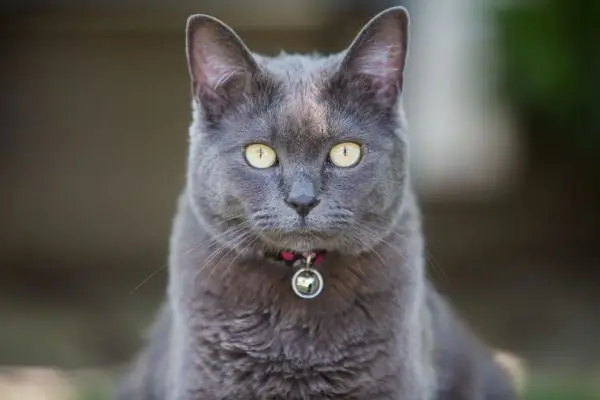
A small tortoiseshell speck is a serious fault in the breed, inherited from representatives of other breeds
External features of Russian blue
The Russian blue has a graceful build and small size. The height at the withers rarely exceeds 25 cm, animals weigh from 3 to 7 kg.
The main feature of the representatives of this breed is the coat - short, very soft, far from the body. The adherence of the coat to the body is considered a fault. The undercoat is the same length as the coat, making it look even thicker and silky.
The color of the coat is uniformly blue with silver tip tipping. Any blotches of other colors are considered a disadvantage. The eyes should be deep green, almost emerald, oval in shape.
A peculiarity of the breed is the pinch - a sharp transition of the cranial part of the head from the cheeks to the muzzle.
Typical types of the Russian blue cat: American, European, English (gallery)
-

Russian blue cat of CFA system - Russian blue cat of American type
-

Russian blue cat of the GCCF system - Russian blue cat of the English type
-

Russian blue cat of WCF system - Russian blue cat of European type
The Australian type, which is sometimes classified as a separate category, is almost entirely consistent with the British.
The character and behavior of the Russian blue cat
Russian blues are smart enough, have a soft character and a pronounced independence. The latter is manifested, for example, in the dislike of animals for closed spaces - any restrictions on freedom are perceived as an insult. Also, animals do not like to be picked up, especially when it comes to unfamiliar people, whom Russian gays simply avoid. At the same time, representatives of this breed are quick-witted and not vindictive, they easily forget their own grievances.
The nature of these animals shows tenderness and affection towards the owners, a desire to participate in everything that happens in the house. At the same time, Russian gays are smart enough to perceive the intonation and tone of a person, so they perfectly understand when their participation is undesirable. When conflict or stressful situations arise, they try to reconcile people and calm them down.
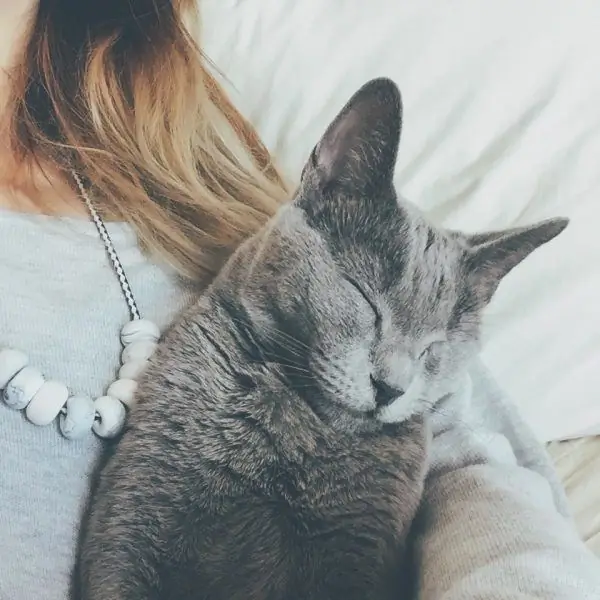
The tenderness of the Russian blue towards their owners is often truly limitless.
These animals are attentive to little things and lend themselves well to training, so that with the right upbringing, they will not spoil furniture, turn flowers or engage in any other Skoda. They easily endure loneliness, the main thing is to prepare some toys for them in advance.
Cats get along well with people. They are equally attached to all family members. During games, they practically do not release their claws. They love children, although they do not allow themselves to be caused unnecessary discomfort, but if the child gets carried away while playing with the animal, the Russian blue simply retires somewhere, in order to return after a while, as if nothing had happened. They also get along very well with other cats and other pets, the only exception can be dogs, but even if a cat does not accept a dog, it simply will not let it come to her.
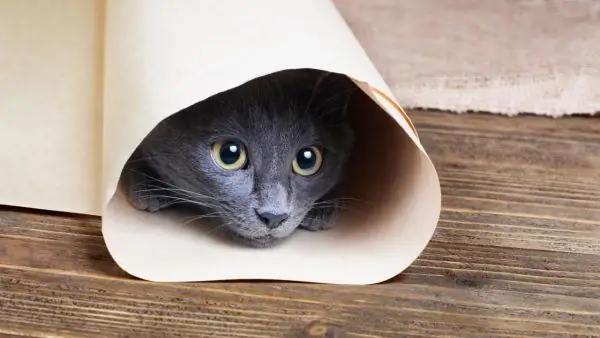
It is easier for Russian blue cats to avoid irritating factors than to actively confront them.
Russian blues are very mobile, they physically need active games, so you should worry about arranging a special structure where you can climb. A bed on a dais will be a definite plus, because the hunting instinct of these cats is very developed, they like to watch the environment from above. In addition, they are very jumpy - they can jump on a high bookcase. They behave very carefully, however, it is still better not to leave fragile things on such surfaces.
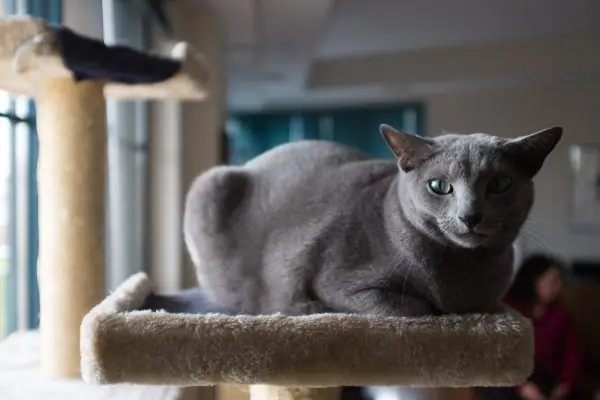
Ready-made houses for cats with beds, stairs and scratching posts - an excellent solution for the Russian blue cat
These cats do not like changes in living conditions, but they love travel. You can often find representatives of this breed on yacht travel around the world. Even a trip to the countryside will be a fascinating adventure for a Russian blue, so if circumstances permit, you can take them with you to a picnic in the countryside or to the country house.
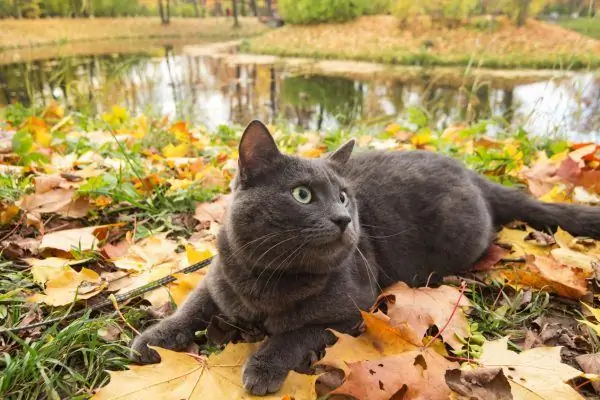
Russian blue cats are very fond of walks in the fresh air.
What diseases do Russian blue cats most often suffer from?
Representatives of this breed do not have their own genetic diseases, although diseases typical for animals of the oriental type may appear - wrinkles on the tail, squint. However, the manifestation of such diseases is incredibly rare.
Also, experts advise to monitor the condition of the bones and teeth of the Russian blue. The best prevention of any disease is quality, balanced nutrition and proper care. Under favorable conditions, representatives of this breed live on average 15 years, although cases of a longer life are not rare - Russian blues are considered centenarians.

Walking in the fresh air is desirable, but not necessary, it is enough to regularly ventilate the apartment
How to care for Russian blue
The main accents in caring for an animal are the organization of proper nutrition, combing during the molting period and regular hygiene procedures. In practice, all this takes very little time, for which this breed is valued separately.
Food
In the case of the Russian blue, felinologists advise not to resort to homemade food, only to industrial feed. The fact is that an imbalance in nutrition affects the health of these cats especially strongly, and it is impossible to achieve an ideal balance of components when preparing food with your own hands. In addition, these animals have an excellent appetite and tend to overeat, and the size of the portion is easiest to control when using commercial feed.
When feeding homemade food, if it is of good quality, you will spend as much money on its ingredients as using good food, and the effect may be worse, and you will have to spend significantly more time. So it is better to follow the logic and organize food with high-quality industrial feed.

Eating high-quality food is very important for the health of the Russian blue cat
Use only high quality super premium and holistic food. From the brands, you can pay attention to Felidae, Grandorf, Almo Nature, Pronature, Arden Grange and similar. When choosing, look at the composition - the list of ingredients should begin with protein or meat, and there should be no cereals and gluten at all. Portions usually depend on the weight of the animal and are indicated on the food packaging. Veterinarians advise feeding cats according to the lower threshold, that is, if a cat weighing 4 kg should consume 50-70 g of feed per day, then it is better to give him 50 g.
For kittens, cats during pregnancy and lactation, as well as cats actively involved in breeding, it is imperative to include vitamin and mineral supplements in the diet.
It is also important to monitor your fluid intake. Water, when feeding on dry food, the animal should drink three times the mass of the consumed food. Water must be used filtered or boiled.
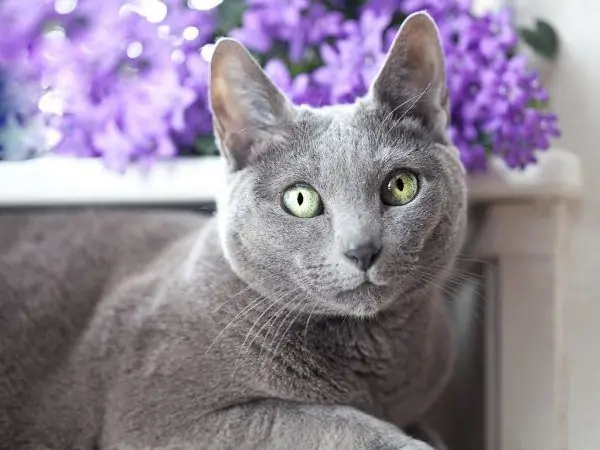
Filtered, boiled or melt water will help Russian blue to avoid urolithiasis
Hygiene
It is advised to bathe animals no more than once every six months. Russian blues don't like water. Bathing is always stressful for them, and they are quite clean on their own.
Clipping the nails is often unnecessary. The blue Russians grind their claws on the scratching post, they do not spoil the furniture, in games the claws practically do not release them. If the need arose nevertheless, before knitting, for example, the claws are carefully trimmed by 1-2 mm using special nippers or ordinary nail clippers. You can brush your pet's teeth once a month using a special toothbrush and toothpaste sold in any pet store.
It is necessary to brush your ears regularly at least once a week. The most convenient way to do this is with ordinary sticks for cleaning the ears, dipped in hydrogen peroxide or a special ear antiseptic, which can also be bought at the pet store. Before cleaning, the swab soaked in liquid must be squeezed out so that excess liquid does not enter the animal's inner ear.
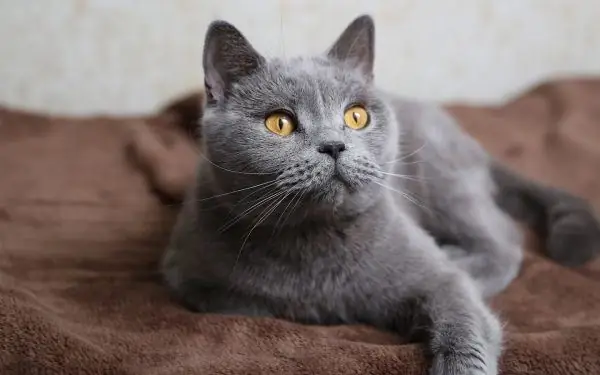
The Russian blue can be stroked with a damp hand a couple of times a week to remove excess hair that has fallen out in the dense undercoat.
Often there is no need to comb the Russian blue. It is enough to brush it once every couple of weeks with a brush with small teeth - this is required more for massaging the skin of the animal, because it copes with the removal of excess hair on its own. Thorough combing is necessary only during the moulting period, about once a week - then you will need a brush with a dense natural bristle for short-haired cats and dogs.
You need to comb it out according to the growth of hair, starting from the neck, then - the chest and sides, last of all - the stomach and paws. You do not need to touch the tail when combing. After combing along the fur of the animal, you need to hold it a couple of times with wet palms, collecting the remnants of the fallen hair. In order for the animal's fur to shine - rub it after combing with a piece of fur or suede.

Russian blues require a minimum of time to care for themselves compared to representatives of other breeds
Restroom
The Russian blue has no peculiarities in toilet training. The choice of place and filler depends more on the preferences of the owner. The tray is usually installed in the bathroom. It is advised to choose trays of a closed type or with high sides, so that when burying, the animal does not scatter the filler.
As a filler, you can use wood, clay or silica gel. You need to choose based on your budget and the preferences of the animal itself. It is important to note that the pet is often accustomed to the type of litter used in its feline childhood and can be difficult to retrain in the future.
Clay fillers are the best option. They retain odor well and are convenient to use. The disadvantage is that they are somewhat dusty. However, in terms of price and quality, they look preferable to other types.
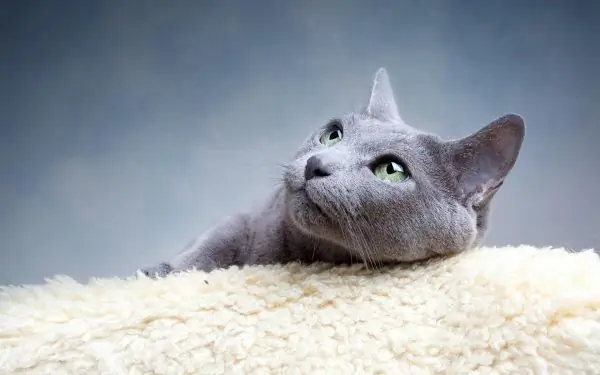
Russian blue cats are very clean, so the litter box will have to be cleaned daily.
Breeding issues of Russian blue
It is important for the owners of animals participating in the breeding establishment to prepare ahead of time for the first mating. And the owners of those cats who are not intended to become parents should worry about timely castration.
There is a common misconception that equates the sex life of a cat and a person. However, it is incorrect to compare them. Cats do not enjoy sex, and periods of sexual activity for them are serious stress. Unrealized sexual instinct can lead to various diseases, mating with representatives of other breeds - to the appearance of sick offspring and, again, health problems in the animals themselves. In a word, if we are not talking about breeding, neutering an animal is the most correct and humane decision, which any veterinarian will confirm to you.

Castration does not affect weight gain, provided proper nutrition
Knitting
Russian blues have a long period of puberty. In cats, the first estrus may begin at 8-10 months, but it is recommended to mate the animal after the third estrus - at 1.5-2 years. Cats can begin to "walk" as early as the first season, even at the age of 6-8 months, however, they are given for the first mating no earlier than at 1.5 years, after the animal's body is fully formed.
The first mating of animals is usually organized with already experienced partners. You can find a partner at a local felinological club, at thematic exhibitions or on the Internet, at local forums. In any case, we are talking about pedigree breeding, so both animals must have a passport, pedigree, be vaccinated and undergo a preliminary medical examination immediately before mating, a certificate of which should be attached to the documents of future kittens. In addition, the owners conclude a mating agreement, which specifies the responsibility of the parties, the remuneration of the cat owners, the procedure for dividing the offspring, the conditions for keeping and certifying kittens.
Mating itself takes place on the territory of the cat and lasts 3-5 days. The cat is brought in on the second or third day of estrus. For the Russian blue, this is a fairly calm process, however, before a viscous animal, it is still better to trim the claws so that they do not injure each other. Animals are left alone for several days, providing them with water, the usual food and toilet. The fact that the mating has taken place can be understood by the behavior of the cat - she becomes calm, fondles the cat, animals lick each other. As a rule, multiple mating occurs during mating. The whole process should not take more than 5 days.
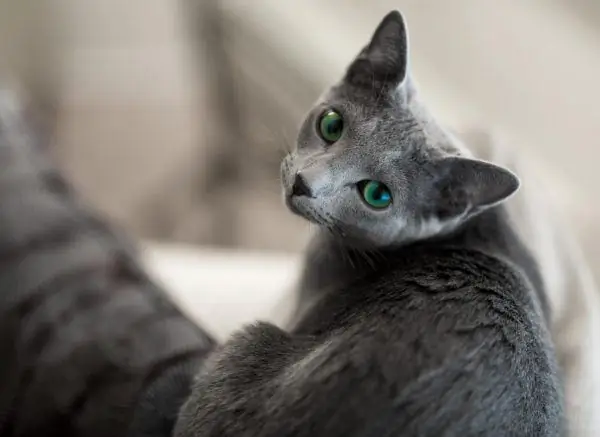
Mating Russian blue is much calmer and quieter than representatives of many other breeds
Pregnancy
You can accurately diagnose pregnancy after 3-4 weeks using an ultrasound machine in a veterinary clinic. Indirect signs can be seen in the behavior of the animal - the cat becomes more phlegmatic, her appetite may become aggravated and nausea may appear, she will make a nest for herself, wear various rags to her house and round out a little at the sides. The gestation period is 65 days on average. Childbirth does not require human participation in young and healthy animals.
A cat gives birth in its house or on a previously prepared nest. In no case should you touch or take away newborn kittens. It is necessary to give the mother cat to lick and feed them. Russian gays are excellent mothers, so you shouldn't worry about offspring. Moreover, cats are very worried when very small kittens are touched by someone. Most likely, after 5-7 days, the cat itself will "bring" you to show its offspring. Then it will already be possible to pick up the kittens.
The sex of kittens can be determined a week after birth. At 10 days, kittens receive the first vaccination, which is repeated after 3-4 weeks. You can inform the club about the appearance of a brood within three weeks after giving birth. The first time you can poison worms at the age of two months.
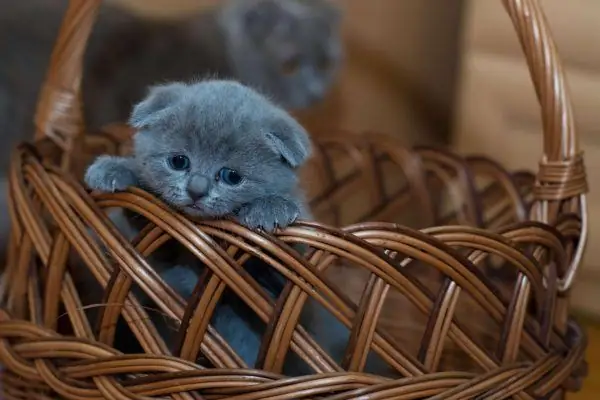
Until about a month old, the ears of Russian blue kittens hang, like those of British and Scottish Fold cats
Castration and sterilization
It is important to distinguish between castration and sterilization. Sterilization is usually understood to mean castration of a female, however, technically, sterilization is the process of removing the uterus in cats or tying the spermatic cords in cats, in which the animal is unable to produce offspring, but continues to be sexually active. Castration is the removal of testicles in cats or ovaries in cats with the impossibility of further having offspring and the absence of a hormonal desire to reproduce.
It is necessary to castrate an animal at the age of 1-1.5 years, when it is fully physically formed, but opinions differ on this matter, so it is better to consult your veterinarian. Some experts advise neutering females after the first mating - then the cat will experience fewer changes in behavior and reduce the risk of hormonal disorders. But in the Russian, blue castration, as a rule, has practically no effect on behavior - the animals remain active, do not lose their hunting qualities, and the cats only become more affectionate.
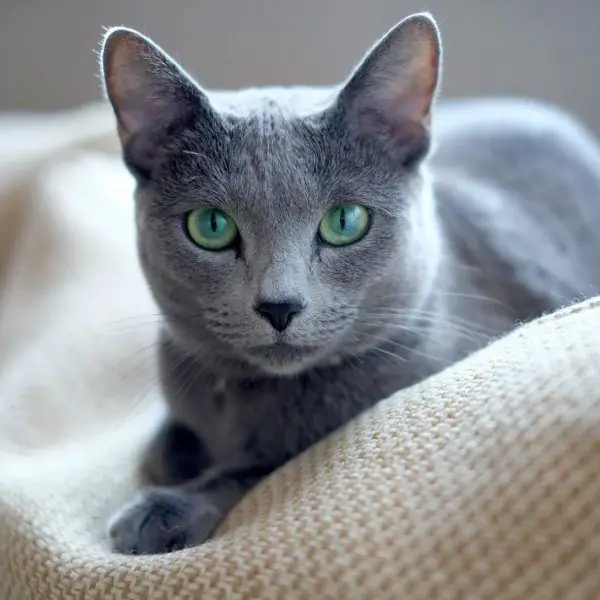
Feline castration is a fairly common and safe operation.
How to choose a kitten Russian blue
Today it is not difficult to find a Russian blue kitten - many nurseries and private breeders are engaged in breeding representatives of this breed. A kitten suitable for breeding will cost 15-20 thousand rubles. A thoroughbred kitten, whose participation in breeding is not planned, will cost up to 10 thousand rubles. Kittens born to pedigree parents without agreement with the club can cost 4-7 thousand rubles. However, the price of the issue may vary in each case.
When choosing a kitten, you need to look at its health. It is advisable to also look at his parents. If you are interested in a purebred animal, then feel free to ask for its documents: pedigree, metric, veterinary passport, vaccination certificate. The kitten itself must be active, playful, make contact. He should not have any extra discharge on the mucous membranes. Ears and skin must be clean.
It is optimal to pick up a kitten at the age of three months. He is already completely independent, accustomed to the tray, he went through the procedures of combing, bathing, trimming claws, brushing ears and teeth in the hands of an experienced breeder. So he is completely ready for an independent life, but at the same time he still lends itself well to education, he is just forming behavioral reactions and developing attachments.
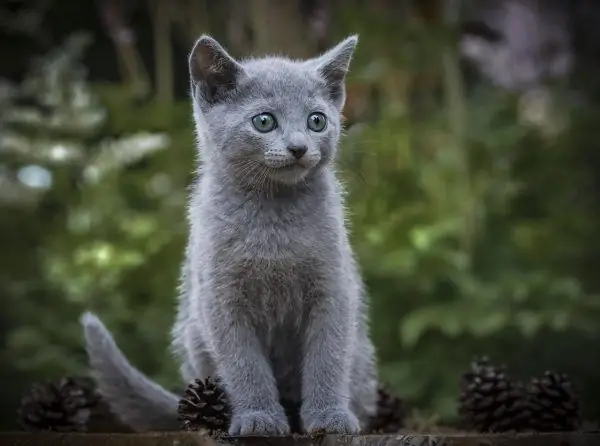
Russian blue kittens can adapt to a new place within a week
Reviews of the owners about the breed

Photo of the kitten provided by the author of the above review
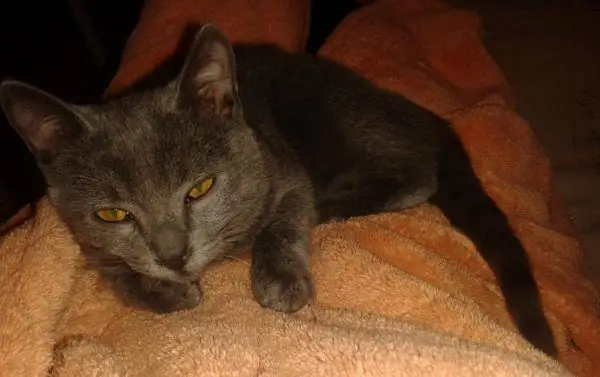
Kitten Vaska, the hero of the review presented above
The popularity of the representatives of this breed is the result of their natural charm, grace, refined manners, playful and attentive behavior to a person, sensitivity and developed mind. They are neat and gentle towards people, quite independent and very mobile. In addition, Russian blues leave very little wool in the apartment, require a minimum of time for grooming, have excellent health and an amazingly soft coat. In a word, this is an excellent candidate for the position of a pet, and the more thoroughbred the animal is, the better it will correspond to all the described merits.
Recommended:
Oriental Cat: Breed Description, Maintenance And Care, Photos, Kitten Selection, Oriental Breeding, Owner Reviews
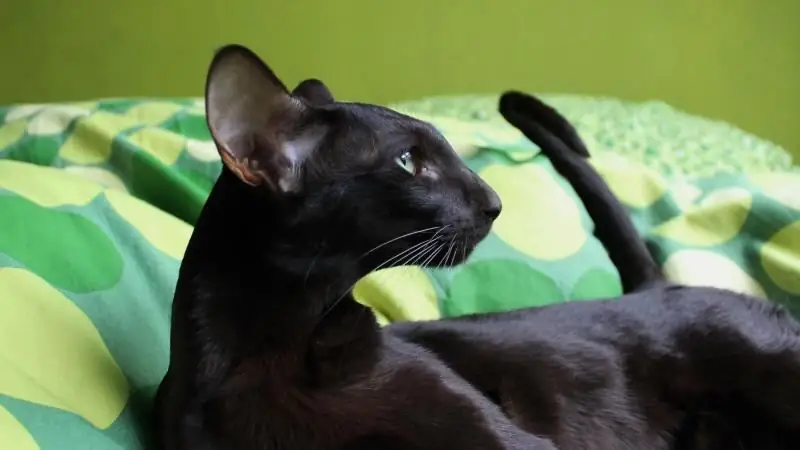
What is the difference between oriental cats and other breeds. Breed standards and temperament. Features of the care, maintenance and feeding of orientals. Choosing a kitten. Breeding
Cat Burmilla: Description Of The Breed, Nature And Features Of The Content, Photos, Choosing A Kitten, Reviews Of The Owners, Breeding Cats
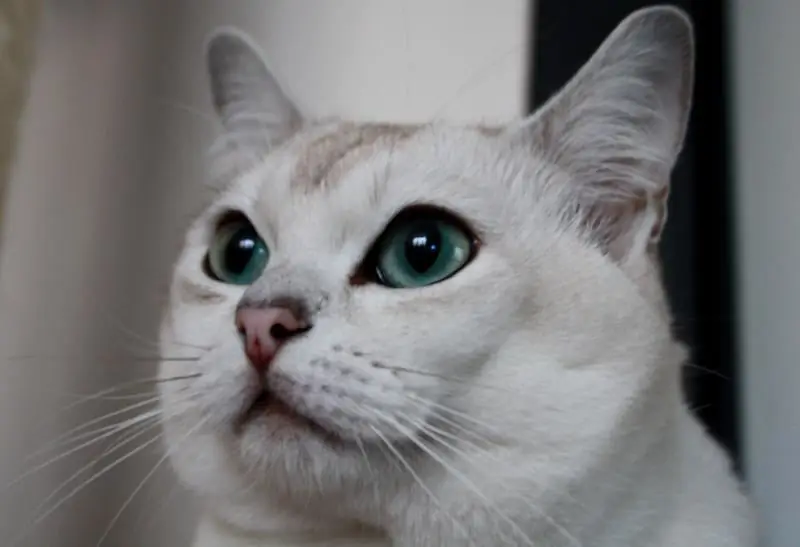
The origin of the Burmilla breed. Features of appearance and behavior. Acquisition and breeding issues. Care and hygiene of the Burmilla. Life expectancy. Reviews
Anatolian Cat: Features Of The Breed's Appearance, Care And Maintenance Of The Cat, Character And Habits, Breeding Pets, Owner Reviews

Where the Anatolian breed is bred. The main external differences, the nature of the pet. How to properly care for him, feed him. How to choose a kitten. Breeding. Reviews
Selkirk Rex: Breed Description, Care And Maintenance, Photos, Breeding Cats, Choosing A Kitten, Owner Reviews

Where the Selkirk Rex breed was bred, its external differences and character. How to properly care for these cats, feed and treat them. How to choose a kitten. Reviews
American Bobtail: Breed Description, Maintenance And Care, Breeding, Owner Reviews, Photos Of Cats

Where the American Bobtail breed was bred, its main differences. The nature of the breed. Proper care, feeding. How to choose a kitten. Reviews of the breed
